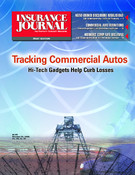Drivers in most of the 13 states that comprise the Western region enjoy about average auto insurance premiums, according to the most recent study produced by the National Association of Insurance Commis-sioners (NAIC).
In NAIC’s “State Average Expenditures and Premiums for Personal Auto Insurance in 2003,” the national average for auto insurance premiums is $820.91. Most Western states are right above or below that figure.
Despite some market improvements and legislative reform, New Jersey has the highest average expenditure, at $1,188.42. Other costly states include New York, at an average expenditure of $1,160.80, and the District of Columbia, at $1,129.31.
According to the study, North Dakota drivers have the lowest average auto insurance premiums, with an average annual auto insurance expenditure of $536.30–35 percent lower than the national average. South Dakota follows, with an average expenditure of $536.18, and Iowa, at $580.15.
Of the Western states, Alaska had the highest average expenditure at $937.72, 14 percent above the national average. Idaho had the lowest average expenditure at $585.35, 29 percent below the national average.
In its report, the NAIC cautions against direct comparisons between state results. Three variables–urban population, miles driven and disposable income per capita–are highly correlated with the numbers. Other variables that can affect differences in average expenditures and premiums include underwriting and loss adjustment expense, accident rates, traffic density, auto repair costs, liability insurance requirements and auto laws, such as those relating to seat belt use and speed limits. The NAIC report does not represent all such variables.
The numbers bear this out: In general, states such as North Dakota, South Dakota and Iowa have lower populations living in more densely population metropolitan areas, and also have drivers who travel fewer miles of roadway.
For example, only 55.8 percent of North Dakota drivers live in urban areas, compared with 94.5 percent in California. Similarly, in 2003, North Dakota drivers traveled well under half a million miles per mile of roadway, compared with California drivers, who averaged a whopping 1.91 million miles per mile of roadway.
The Western states with average expenditures just above the countrywide average included: Alaska, Arizona, California, Colorado, Nevada and Washington. With the exception of Alaska, those states had a high percent–80 percent or more–of their populations living in metropolitan areas. Approximately 66 percent of Alaska’s population lives in metropolitan areas.
Western states with average expenditures below the nationwide average included Hawaii, Idaho, Montana, New Mexico, Utah and Wyoming. With the exception of Hawaii, millions of miles driven in those states were relatively low. Montana drivers covered just 0.16 miles, while Hawaii drivers covered 2.16 miles.
Generally, auto insurance premiums countrywide have shown a gradual increase from 1999 to 2003. In 1999, the average expenditure was $685.09, going to $689.27 in 2000, $723.11 in 2001, $776.78 in 2002, and $820.91 in 2003.
NAIC gleans the report’s statistics from a variety of sources, including the American Association of Insurance Services, ISO Data Inc., the National Independent Statistical Service and the Property Casualty Insurance Association of America.
NAIC noted that the 2003 California auto insurance premium data in its report is preliminary. The California Department of Insurance performs annual tests on the data to ensure accuracy, and the tests were not yet completed at the time of publication. Adjustments will be reflected in the next edition of NAIC’s report.
Topics California Auto
Was this article valuable?
Here are more articles you may enjoy.


 Business Moves: ALKEME Expands in US With Addition of 5 Agencies
Business Moves: ALKEME Expands in US With Addition of 5 Agencies  Warburg Mulls $1 Billion Sale of London Insurance Broker McGill
Warburg Mulls $1 Billion Sale of London Insurance Broker McGill  Allstate Can Proceed With Recovery in Texas RICO Case: Fifth Circuit
Allstate Can Proceed With Recovery in Texas RICO Case: Fifth Circuit  Experian: AI Agents Could Overtake Human Error as Major Cause of Data Breaches
Experian: AI Agents Could Overtake Human Error as Major Cause of Data Breaches 


